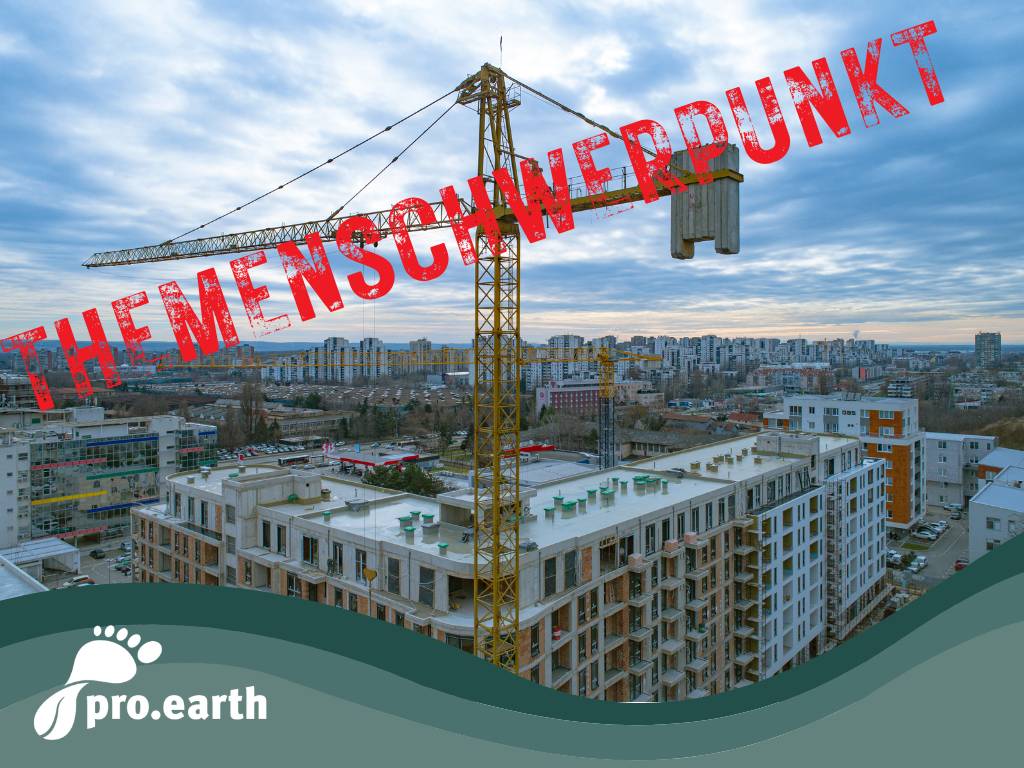Why we need a turnaround in construction

Without drastic changes in the construction industry, we will miss the Paris climate targets. Our buildings are responsible for 38 percent of all CO2 emissions worldwide and 30 percent in Germany. This includes both the construction and operation - hot water, heating, electricity and air conditioning - of buildings. In addition to the enormous consumption of resources in the construction industry, the recycling rate is very low.
"In the EU, the construction sector generates over 35% of all waste and is responsible for around 50% of all raw material extraction. The necessary reduction inCO2 emissions and resource consumption poses major challenges for the building materials industry," according to a study on the recyclability of our building materials.
In Germany alone, around 517 million tons of mineral raw materials are used every year, including lime, gypsum stone, gravel and sand. In addition, around 200 million tons of waste are generated by the construction of new buildings and the demolition/renovation of old ones. According to the Federal Statistical Office, this makes the construction industry the largest producer of waste at 53 percent. Not forgetting the consumption of land by new buildings, which are responsible for 70 percent of annual soil sealing.
"We really are a key sector for more climate protection"
Tim-Oliver Müller, Managing Director of the Federation of the German Construction Industry
The proportion of gray energy
The energy required to construct a building from the foundation to the roof is called gray energy. This also includes the production of the required building materials, whereby the production of concrete in particular is very harmful to the climate, because on the one hand it contains the increasingly scarce raw material sand/gravel and on the other hand the production of the binding agent cement generates high greenhouse gas emissions. Grey energy also includes the demolition and disposal of the building materials. According to the Federal Institute for Research on Building, Urban Affairs and Spatial Development, this accounts for an average of a quarter of the total emissions of a conventionally constructed building.
https://news.pro.earth/2023/05/08/nachhaltig-bauen-was-heisst-das-eigentlich/
The love of money and the lack of will
In the construction industry in particular, attention is paid to every euro and many building materials that are not sustainable are unfortunately cheaper to buy than climate-friendly ones. A good example of this is thermal insulation with polystyrene, which is cheaper, but has to be removed from houses in 20-30 years at great expense - including financial expense - and has to be specially disposed of. This example illustrates the dilemma that architect Ragnhild Klußmann describes quite well:
"Profitability cycles have become shorter and shorter. Whereas a building used to be considered over 30 years, every investor now says that it should have paid for itself after seven to ten years." Given the high economic pressure, it is difficult to build sustainably, long-term and to a high standard of quality - without becoming much more expensive.
Solutions must be found
There are plenty of ideas and approaches. The problem is also known at EU level: "Our buildings cause 40 percent of our emissions. They must become less wasteful, less expensive and more sustainable," says the President of the European Commission, Ursula von der Leyen.
Solutions have also been proposed at many levels, for example by the Association of German Architects, the German Sustainable Building Council (DGNB) and the Architects for Future (AFF) association.
"It's like a marathon," says Christine Lemaitre, head of the DGNB. "There are many who do it easily and consistently and we have a large number who have just started out."
"Reduce, reuse, recycle" is a very important aspect of sustainable construction. The AFF association believes that politicians have a role to play and has also launched a petition on the subject, which has been signed by over 50,000 people. In it, AFF demands, among other things, that the legal minimum standards for sustainable building be raised, which today do not even take into account grey emissions in the Building Energy Act, criticizes Burgbacher. Architects for Future are of the opinion that sustainable construction can only be implemented with the help of legislative changes, new laws or targeted funding programs: "Sustainable construction must get out of the nice-to-have economic sphere."
Some key requirements are
- working with what already exists instead of building something new on a greenfield site,
- make much greater use of sustainable building materials
- Materials should be degradable and recyclable
- Urban mining - this refers to the recyclability of materials from existing buildings
- New rules for building renovations
- Making it more difficult to demolish buildings
- Training of craftswomen, architects and engineers: redesigning curricula towards climate-friendly, sustainable construction
Turning old into new
"One of the most important principles we advocate is to avoid demolition," says Veit Burgbacher from the Architects for Future (AFF) association. "The gray energy contained in every building is irretrievably lost if they are torn down." Burgbacher believes that only a few buildings are not worth preserving because their substance is too poor, but the main problem is that many building owners lack the will to renovate them.
The basic questions
We need to ask ourselves how much living space we really need and whether the existing living space could perhaps accommodate more people through targeted conversion. Alternative housing models such as retirement flatshares or senior citizens plus students etc. need to be considered much more and the existing living space used more efficiently in order to reverse the trend of "eating up" more and more land and raw materials.






